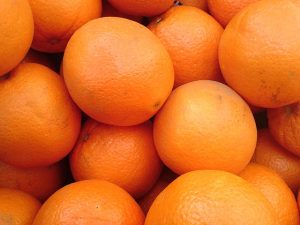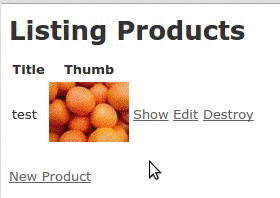Dragonfly gem: images and files in Rails models (Paperclip alternative)
Let's say you want to add a picture field to your product model. How do you do it?
Unfortunately, Rails' Active Record doesn't provide a native way to work with binary fields, like pictures. We can easily add a string field, but we can't add a file field.
Dragonfly is a gem that extends ActiveRecord, allowing to have binary fields, like videos, files, or... pictures. It's a good, or even better, alternative to the famous Paperclip gem.
# Before we start
Let's create an example app with these commands:
rails new test_df
cd test_df
rails g scaffold product title
rake db:migrate
rails s
# Installation
# 1. Declare DragonFly gem on Gemfile
# Gemfile
gem 'dragonfly'
# 2. Install it
bundle install
# 3. Generate the initializer file
rails g dragonfly
This command generates a config/initializers/dragonfly.rb file, which can be used to configure DragonFly's core settings.
# Creating an image field
To add a normal string field like color, we create a migration like this:
rails g migration add_field_to_product color
That's how we create a color string field. To create a Dragonfly field, you need to add an _uid at the end of the name. So, in this example, the name would be color_uid. If the name is photo, that would be photo_uid.
Let's use image as the field name:
rails g migration add_field_to_product image_uid
Commit the changes with rake db:migrate:
rake db:migrate
Now open the product model and let Rails know this field isn't a string, but a file:
# app/model/product.rb
dragonfly_accessor :image
# Saving a file to a record
# 1. For our test, save this image in your Images folder as 1.jpg

# 2. Open the rails console
rails c
# 3. Load the image file, get a record, put the image on it, and save it
> i = open('../../Images/1.jpg')
> p = Product.last
> p.image = i
> p.save!
WARNING
We are using ../../Images, because my project is at ~/projects/test-dragonfly, i.e., 2 folders from ~/Images. Change it at your will.
# 4. Close the console and re-open it again to make sure the image has been saved
> quit
rails c
> p = Product.last
> p.image
# => <Dragonfly Attachment uid="2015/09/26/4ad07k6hin_1.jpg", app=:default>
If p.image isn't nil, it has been saved.
# Retrieving
# 1. To get the file path, use the url method
> p.image.url
# => "/media/W1siZiIsIjIwMTUvMDkvMjYvNGFkMDdrNmhpbl8xLmpwZyJdXQ?sha=0d7af674c4891620"
# 2. Copy and paste the result on the browser and you will see the file
http://localhost:3000/media/W1siZiIsIjIwMTUvMDkvMjYvNGFkMDdrNmhpbl8xLmpwZyJdXQ?sha=0d7af674c4891620
# 3. For images, we can use the thumb method. It generates a new version with different geometries
> p.image.thumb('80x60').url
=> "/media/W1siZiIsIjIwMTUvMDkvMjcvOGNiNHFmbTU0M18xLmpwZyJdLFsicCIsInRodW1iIiwiODB4NjAiXV0?sha=1931e3387c6b54f5"
# 4. Copy and paste the result on the browser and see the same image with the new dimensions
# Dragonfly is on-the-fly
In the rails server window, we can see the logs showing that DragonFly is generating the file on the fly:

Whenever someone loads the thumb image on a browser, Dragonfly gets the original image and converts it, generating a new image.
To see this process happening, just reload the image on the browser and check the logs.
That's why DragonFly has this name – it's on-the-fly, like a Dragonfly 😃
# Displaying on index.html and show.html
Now, let's show these images as thumbs in our product index page.
# 1. Open index.html.erb and create a thumb column
Use image_tag() to generate an HTML image tag and the thumb() method to generate a smaller version of the image.
Simplified example:
<!-- apps/views/products/index.html.erb -->
<table>
<tr>
<th>Title</th>
<th>Thumb</th>
</tr>
<% @products.each do |product| %>
<tr>
<td><%= product.name %></td>
<td><%= image_tag product.image.thumb('80x60').url %></td>
</tr>
<% end %>
</table>
Result:
# 2. Do the same for show.html.erb
<!-- apps/views/products/show.html.erb -->
<p>
<strong>Image:</strong>
<%= @product.image.url %>
</p>
# 3. Check if the image exists
If you run the above code you are going to get an exception. That's because you have some records without any image attached, and you're calling thumb/url methods from a nil value.
To check if the field has an attached file or not, use Rail's core nil? method or use the _stored? method:
<!-- apps/views/products/show.html.erb -->
<%= product.image_stored? ? image_tag(product.image.thumb('80x60').url) : "" %>
OR
<!-- apps/views/products/show.html.erb -->
<%= product.image.nil? ? image_tag(product.image.thumb('80x60').url) : "" %>
# Using it on forms
We've added images using the console. But how to save the image through a form?
With DragonFly, we can do it in the same way that we would do with a normal field.
# 1. Open _form.html.erb, create a new HTML field with the corresponding name, and use the file_field method to generate a HTML file field
<!-- app/views/products/_form.html.erb -->
<%= form_for(@product) do |f| %>
<div class="field">
<%= f.label :title %><br>
<%= f.text_field :title %>
</div>
<div class="field">
<%= f.label :image %><br>
<%= f.file_field :image %>
</div>
<div class="actions">
<%= f.submit %>
</div>
<% end %>
# 2. Like other fields, we must allow it in strong parameters
# app/controllers/products_controller.rb
...
def product_params
params.require(:product).permit(:title, :image)
end
...
Now we can send and save an image using the form:

# Performance with cache
As DragonFly gem generates new versions on the fly, it can be very resource-consuming, so we need to use a server cache solution.
Let's add the rack-cache gem.
# 1. Add it to Gemfile
# Gemfile
gem 'rack-cache', require: 'rack/cache', group: :production
# 2. Install it
bundle install
# 3. Enable it on production
# config/environments/production.rb
config.action_dispatch.rack_cache = true
# 4. Set the cache's temporary folder
# config/application.rb
class Application < Rails::Application
...
if defined?(Rack::Cache)
config.middleware.delete(Rack::Cache)
config.middleware.insert 0, Rack::Cache, {
:verbose => true, # log verbosity
:metastore => URI.encode("file:#{Rails.root}/tmp/dragonfly/cache/meta"), # URI encoded in case of spaces
:entitystore => URI.encode("file:#{Rails.root}/tmp/dragonfly/cache/body")
}
end
end
TIP
You don't need to do this if you already use a server cache solution like Varnish.
# Validation
Use validates_property method on the model to validate properties. Examples:
# app/models/product.rb
class Product < ActiveRecord::Base
dragonfly_accessor :image
validates_property :width, of: :image, in: (0..400)
validates_property :mime_type, of: :image, in: %w(image/jpeg image/png)
validates_property :size, of: :image, maximum: 500.kilobytes
end
As an example, let's say you want to validate if the attachment is an image or something else. With this you can make sure your users aren't uploading movies or applications:
# app/models/product.rb
class Product < ActiveRecord::Base
dragonfly_accessor :image
validates_property :mime_type, of: :image, in: %w(image)
end
See a full list of validations here: https://markevans.github.io/dragonfly/models#validations (opens new window)
# S3, Dropbox, Watermarks and More
This concludes our basic DragonFly gem tutorial, but DragonFly has also many advanced features: you can use Amazon S3, Dropbox, and other providers as your storage. You can change the image on-the-fly in so many ways: add a watermark, change to black and white, change the file format, and so on. You can also create your own plugins to extend DragonFly.
You can also work with other binary types like movies or apps, but I won't cover these things here. Maybe on other tutorial 😉
# Common problems
- "404 - Not Found: If you get this error, you probably don't have
ImageMagickinstalled. On Ubuntu, run asudo apt-get install imagemagickto fix it.
# More info
- DragonFly gem: https://markevans.github.io/dragonfly/ (opens new window)
- On GitHub: https://github.com/markevans/dragonfly (opens new window)
- DragonFly author: Mark Evans